|
 |
Edward Henry Potthast Prints
|
|
American Impressionist Painter, 1857-1927
Edward Henry Potthast (1857 ?C 1927) was an American Impressionist painter.
He was born in Cincinnati, Ohio. From June 10, 1879 to March 9, 1881 he studied with Thomas Satterwhite Noble. He later studied at the Royal Academy in Munich with the American-born instructor Carl Marr. After returning to Cincinnati in 1885 he resumed his studies with Noble. In 1886 he departed for Paris, where he studied with Fernand Cormon. In 1895 he relocated to New York City and remained there until his death in 1927. |
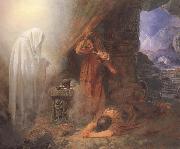 |
Edward Henry Corbould,RI,RWS
|
|
1815-1905
Painter, illustrator and sculptor, son of (2) Henry Corbould. A pupil of Henry Sass (1788-1844) and a student at the Royal Academy, he showed more wide-ranging interests than his father or uncle. He worked in watercolour and briefly in sculpture, winning gold medals for both from the Society of Arts (Fall of Phaeton, watercolour, 1834; St George and the Dragon, sculpture, exh. RA 1835; both untraced). He designed monumental figures for an unexecuted London County Council sculpture project for Blackfriars Bridge (1889), but he concentrated primarily on watercolours of literary and historical subjects, which he exhibited with the New Water-Colour Society from 1837 until 1898. |
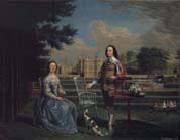 |
Edward Haytley
|
|
British Painter, active 1740-ca.1762,was an English portrait and landscape painter of the 18th century. Little is known about him, but the background of some of his sitters and professional contacts suggest he may have come from Lancashire. Few of his works survive, but he appears to have specialised in the "conversation piece" form popular with the landed gentry of mid-18th century England, a group portrait against an idealised backdrop of the subjects' estates. His works of this form include one of Elizabeth Robinson with her parents, Edward and Elizabeth Montagu, at Sandleford Priory near Hythe, Kent; six portraits of the Stanley family including one of Sir Robert and Lady Bradshaigh in front of Haigh Hall; and two of the Brockman family on its Kent estate, Beachborough, both showing the newly-constructed Temple Pond. One of the latter may include Susanna Highmore, daughter of the portrait painter Joseph Highmore. His best known works are the oil-on-canvas roundels of Bethlem and Chelsea Hospitals donated in 1740, at the behest of William Hogarth, to the Foundling Hospital, London. His last recorded work was a conversation piece of William Milner, second baronet, dated 1764, and he is assumed to have died shortly after this date |
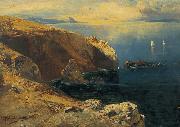 |
Eduard Hildebrandt
|
|
(1818 - October 25, 1868) was a German painter.
He served as apprentice to his father, a house-painter at Danzig. He was not twenty when he came to Berlin, where he was taken in hand by Wilhelm Krause, a painter of sea pieces. Several early pieces exhibited after his deathea breakwater, dated 1838, ships in a breeze off Swinemunde (1840), and other canvases of this and the following yeareshow Hildebrandt to have been a careful student of nature, with inborn talents kept down by the conventionalisms of the formal school to which Krause belonged.
Accident made him acquainted with masterpieces of French art displayed at the Berlin Academy, and these awakened his curiosity and envy. He went to Paris, where, about 1842, he entered the atelier of Isabey and became the companion of Lepoittevin. In a short time he sent home pictures which might have been taken for copies from these artists. Gradually he mastered the mysteries of touch and the secrets of effect in which the French at this period excelled.
He also acquired the necessary skill in painting figures, and returned to Germany, skilled in the rendering of many kinds of landscape forms. His pictures of French street life, done about 1843, while impressed with the stamp of the Paris school, reveal a spirit eager for novelty, quick at grasping, equally quick at rendering, momentary changes of tone and atmosphere.
After 1843 Hildebrandt, under the influence of Humboldt, extended his travels, and in 1864-1865 he went round the world. Whilst his experience became enlarged his powers of concentration broke down. He lost the taste for detail in seeking for scenic breadth, and a fatal facility of hand diminished the value of his works for all those who look for composition and harmony of hue as necessary concomitants of tone and touch.
In oil he gradually produced less, in water colours more, than at first, and his fame must rest on the sketches which he made in the latter form, many of them represented by chromolithography. Fantasies in red, yellow and opal, sunset, sunrise and moonshine, distances of hundreds of miles like those of the Andes and the Himalaya, narrow streets in the bazaars of Cairo or Suez, panoramas as seen from mast-heads, wide cities like Bombay or Pekin, narrow strips of desert with measure-less expanses of skyall alike display his quality of bravura. Hildebrandt died at Berlin on the 25th of October 1868.
|
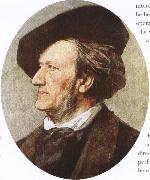 |
eduard hanslick
|
|
German music critic, aesthetician and pioneer of musical appreciation. He studied music with Tom??šek and read law at Prague University, writing his earliest essays for the Prague journal Ost und West and for the Wiener Musikzeitung, the Sonntagsblätter and the Wiener Zeitung. From 1849 to 1861 he was a civil servant, chiefly for the ministry of culture, meanwhile writing for the Presse, publishing his important book Vom Musikalisch-Schönen (1854) and lecturing on music appreciation at Vienna University, becoming full professor in 1870. He was also active as a musical emissary and helped promote the standardization of musical pitch. Among his long-standing friends were Brahms and the philosopher Robert Zimmermann. Though his aesthetic enshrined the classical ideals of orderliness and formal perfection, his interests were limited to the music of his own time. |
 |
Ecce Homo
|
|
are the Latin words used by Pontius Pilate in the Vulgate translation of the John 19:5, when he presents a scourged Jesus Christ, bound and crowned with thorns, to a hostile crowd shortly before his Crucifixion. The King James Version translates the phrase into English as Behold the Man. The scene is widely depicted in Christian art.
The Ecce homo is a standard component of cycles illustrating the Passion and Life of Christ in art. It follows the Flagellation of Christ, the Crowning with thorns and the Mocking of Christ, the last two often being combined. The usual depiction shows Pilate and Christ, the mocking crowd and parts of the city of Jerusalem.
But, from the 15th century, devotional pictures began to portray Jesus alone, in half or full figure with a purple robe, loincloth, crown of thorns and torture wounds, especially on his head. Similar subjects but with the wounds of the crucifixion visible (Nail wounds on the limbs, spear wounds on the sides), are termed a Man of Sorrow(s) (also Misericordia). If the "Instruments of the Passion" are present, it may be called an Arma Christi. If Christ is sitting down (usually supporting himself with his hand on his thigh), it may be referred to it as Christ at rest or Pensive Christ. It is not always possible to distinguish these subjects.
|
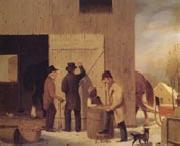 |
Durrie George Henry
|
|
American Painter
b.1820 d.1863
Durrie and his older brother John (1818-98) studied sporadically from 1839 to 1841 with the portrait painter Nathaniel Jocelyn. From 1840 to 1842 he was an itinerant painter in Connecticut and New Jersey, finally settling permanently in New Haven. He produced c. 300 paintings, of which the earliest were portraits (e.g. Self-portrait, 1839; Shelburne, VT, Mus.); by the early 1850s he had begun to paint the rural genre scenes and winter landscapes of New England that are considered his finest achievement. His landscapes, for example A Christmas Party (1852; Tulsa, OK, Gilcrease Inst. Amer. Hist. & A.), are characterized by the use of pale though cheerful colours and by the repeated use of certain motifs: an isolated farmhouse, a road placed diagonally leading the eye into the composition, and a hill (usually the West or East Rocks, New Haven) in the distance. By the late 1850s Durrie's reputation had started to grow, and he was exhibiting at prestigious institutions, such as the National Academy of Design. In 1861 the firm of Currier & Ives helped popularize his work by publishing prints of two of his winter landscapes, New England Winter Scene (1858; Mr and Mrs Peter Frelinghuysen Carleton priv. col.) and the Farmyard in Winter. |
 |
Dirck Hals
|
|
Dutch
1591-1656
Dirck Hals Galleries
Dirck Hals (born at Haarlem, 1591-1656) was a Dutch painter of festivals and ballroom scenes. He was influenced by his elder brother Frans Hals. |
 |
David Octavius Hill
|
|
Scottish Painter and Photographer,
1802-1870
was a founding member of the Royal Scottish Academy and its secretary for 40 years. In 1843 he enlisted the help of Robert Adamson (b. 1821, Berunside, Scot. January 1848, St. Andrews), a chemist experienced in photography, in photographing the delegates to the founding convention of the Free Church of Scotland. They used the calotype process, by which an image was developed from a paper negative. In these and other portraits they demonstrated a masterly sense of form and composition and a dramatic use of light and shade. Their five-year partnership resulted in some 3,000 photographs, including many views of Edinburgh and small fishing villages. |
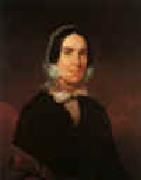 |
David Hunter Strother
|
|
1816-1888
Strother was born in Martinsburg, Virginia (now West Virginia). He studied drawing under Pietro Aneora in Philadelphia, Pennsylvania from 1829 to 1836 when he became a student of Samuel F. B. Morse in New York. Strother was an artist for The Crayon, the leading art journal of the United States at the time, and a frequent contributor to Harper's Monthly. Most of his early work was comprised of landscapes and other outdoor scenes. His art pertained mostly to Virginia and the Southern United States. Prior to the American Civil War, his art was published in books titled The Blackwater Chronicle (1853) and Virginia Illustrated (1857).
During the Civil War, Strother was commissioned by the U.S. Army and assigned as a topographer due to his detailed knowledge of the Shenandoah Valley. During this time, Strother recorded his experiences in the war which he would later publish in Harper's Monthly as "Personal Recollections of the War." His accounts are considered to be unique and are highly praised for their objective viewpoint. He was involved in 30 battles, though never wounded, and was brevetted brigadier general by the War's end.
After the war, topics of his pieces covered a wider range of subjects. Strother began to make works which commented on politics and race relations. He even sketched a portrait of Chief Sitting Bull. Some of his drawings were merely of individuals and groups going about their daily lives.
Strother ended his career as an artist when he was appointed by President Rutherford B. Hayes to be the General Consul to Mexico City in 1879. He returned to West Virginia in 1885 and died there three years later. The New York Times published an obituary in which it is stated that his name was a household one during his career. Strother is buried in Green Hill Cemetery in Martinsburg, West Virginia. |
 |
david hockney
|
|
Born: 9 July 1937
Birthplace: Bradford, England
Best Known As: British pop artist and critic |
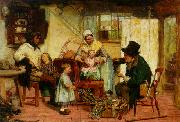 |
David Henry Friston
|
|
(1820 - 1906) was a British illustrator and figure painter in the Victorian Era. He is best remembered as the creator of the first illustrations of Sherlock Holmes in 1887, as well as his illustrations of the controversial female vampire story Carmilla (1872). He is also remembered for his illustrations accompanying reviews of Gilbert and Sullivan operas and plays of W. S. Gilbert in The Illustrated London News and the Illustrated Sporting and Dramatic News in the 1870s and 1880s.
|
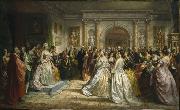 |
Daniel Huntington
|
|
(October 4, 1816 -April 19, 1906), American artist, was born in New York City, New York, the son of Benjamin Huntington, Jr. and Faith Trumbull Huntington; his paternal grandfather was Benjamin Huntington, delegate at the Second Continental Congress and First U.S. Representative from Connecticut.
In 1835 he studied with Samuel F.B. Morse, and produced "A Bar-Room Politician" and "A Toper Asleep." Subsequently he painted some landscapes on the Hudson river, and in 1839 went to Rome. On his return to America he painted portraits and began the illustration of The Pilgrim's Progress, but his eyesight failed, and in 1844 he went back to Rome.
Returning to New York around 1846, he devoted his time chiefly to portrait-painting, although he painted many genre, religious and historical subjects. From 1851 to 1859 he was in England. He was president of the National Academy from 1862 to 1870, and again in 1877-1890.
|
 |
cornelius hoyer
|
|
Cornelius Höyer, född 1741, död 1804, var en dansk målare.
Höyer studerade dels i Köpenhamn, dels i Paris och Italien samt var redan 1769, då han återkom hem, en ansedd konstnär inom sitt fack, miniatyrmåleriet. 1770 blev han hovminiatyrmålare och medlem av konstakademien. Från 1777 var han dennas sekreterare.
|
 |
Cornelisz van Haarlem
|
|
1562-1638
Dutch
Cornelisz van Haarlem Galleries
Dutch painter and draughtsman. He came from a wealthy family. During the Spanish siege and occupation of Haarlem (1572-7), his parents moved elsewhere, leaving their son and large house in the protection of the painter Pieter Pietersz. (1540/41-1603), who became Cornelis's teacher. In 1579 Cornelis travelled to France by sea, but the journey terminated at Rouen because of an outbreak of plague. He then became a pupil of Gillis Congnet in Antwerp, with whom he stayed for one year. In 1580-81 he returned permanently to Haarlem, and in 1583 he received his first official commission from the city, a militia company portrait, the Banquet of the Haarlem Civic Guard (Haarlem, Frans Halsmus.). Around 1584 he befriended Hendrick Goltzius and Karel van Mander, with whom he is said to have established a kind of academy. |
 |
Cornelis Holsteyn
|
|
(1618 - 2 December 1658) was a Dutch Golden Age painter from Haarlem.
According to the RKD he was a painter of historical allegories, portraits, and interior decorations, trained by his father Pieter Holsteyn I. According to Houbraken, his father was a glass painter, and thus was trained for glass painting, but the market in glass painting not being what it was, he turned his hand to painting canvas. Houbraken felt he received less for a painting than he deserved, because his work was of a very high quality. He describes a Triumph of Bacchus, and a Lycurgus, which was painted for the Amsterdam Orphanage.
According to the RKD, he moved to Amsterdam with his brother Pieter Holsteyn II in 1647, became poorter there in 1652, and was betrothed there on Christmas eve, 1654. He was buried in the Nieuwe Kerk on December 2, 1658 from his home on the Rozengracht. Houbraken claimed he had been fit until his sudden death by Hartvang, or heart-attack.
|
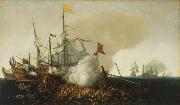 |
Cornelis Hendriksz Vroom
|
|
(1591, Haarlem - buried September 16, 1661, Haarlem) was a Dutch Golden Age landscape painter.
According to the RKD he was the son of the painter Hendrick Cornelisz Vroom, the older brother of Frederick and Jacob, and the father of the painter Jacob Cornelisz Vroom.[1] He became a member of the Haarlem Guild of St. Luke in 1634.
According to Houbraken in 1718, who repeated a list of names from Theodorus Schrevelius's 1648 book on Haarlem called Harlemias, he was the son of Hendrick Cornelisz Vroom and a good landscape painter of Haarlem along with "Joh. Jakobsz.", who was in Italy for many years, "Nicol. Zuyker", Gerrit Claesz Bleker, Salomon van Ruysdael, and Reyer van Blommendael. |
 |
Cornelis de Heem
|
|
Dutch Baroque Era Painter, 1631-1695
Son of Jan Davidsz. de Heem. He spent a great deal of his life in Antwerp, where he was taught by his father. Cornelis also worked in Utrecht in 1667, in nearby IJsselstein in 1676 and in The Hague from 1676 for more than ten years. His best works approach the quality of his father, particularly in works executed during the decade starting in 1655. Cornelis still-lifes can be distinguished by daring colour harmonies, sometimes with a strong blue. His compositions are often simpler: fruit-pieces, floral bouquets, festoons and garlands and sumptuous still-lifes, only occasionally in large formats. His technique changed from a more painterly to a more graphic style. |
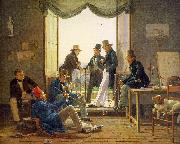 |
Constantin Hansen
|
|
Danish
1804-1880
Constantin Hansen Galleries
Danish painter. In 1816 he entered the Kongelige Akademi for de Sk?nne Kunster, Copenhagen, intending to study architecture; however he later became attracted to painting and worked under C. W. Eckersberg from 1828 to 1833. Around the middle of the 1820s he started developing an individual style of portraiture, which had matured by 1830. He often used his sisters and friends as models; using simple costumes, poses and compositions, he managed to endow his pictures with the intimacy and warmth that mark the Danish Golden Age. The Artist's Sisters Signe and Henriette Reading a Book (1826; Copenhagen, Stat. Mus. Kst) is a fine example of his combination of natural observation with Neo-classical idealization. Under Eckersberg, who encouraged both, he strengthened his natural flair for painting serene architectural views of Copenhagen. |
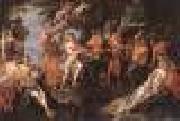 |
CLERCK, Hendrik de
|
|
Flemish Baroque Era Painter, ca.1570-1630
Flemish painter and draughtsman. In 1587 he was working in Rome with the Brussels painter Frans van de Kasteele. That he subsequently lived in Brussels is confirmed by documentary evidence and by his status as court painter to the governors of the southern Netherlands. Stylistically, de Clerck's work (both paintings and drawings) is close to that of the Antwerp late Mannerist Marten de Vos, traditionally thought to have been his teacher, but it is possible that he was apprenticed to Joos van Winghe in Italy. He was later a member of the Brussels painters' guild, where from 1601 to 1611 Jan van Overstraeten was registered as his pupil. It was in 1594 that de Clerck was appointed court painter in Brussels, first to Archduke Ernest. In 1596, after the Archduke's death, his brother Emperor Rudolf II arranged for de Clerck to stay on as court painter in the service of the new Archdukes, Albert and Isabella. In 1609 de Clerck and Wenceslas Cobergher were commissioned to decorate the ceiling of the oratorium in the archducal palace in Brussels |
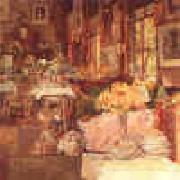 |
Childe Hassam
|
|
1859-1935
Childe Hassam Locations
Frederick Childe Hassam (b. October 17, 1859, Dorchester, Boston, Massachusetts ?C d. August 27, 1935, East Hampton, New York) was a prominent and prolific American Impressionist painter, noted for his urban and coastal scenes. Along with Mary Cassatt and John Henry Twachtman, Hassam was instrumental in promulgating Impressionism to American collectors, dealers, and the museums. He produced over 3,000 paintings, watercolors, etchings, and lithographs in his career, and was a founding member of The Ten, an influential group of American artists of the early 20th century. His most famous works are the ??Flag?? paintings, completed during World War I.
Hassam (pronounced HASS'm;) (known to all as Childe, pronounced like child) was born in his family home in a suburb of Boston in 1859. His father Frederick was a cutlery merchant and descended from a long line of New Englanders, while his mother Rosa was a native of Maine. He demonstrated an interest in art early in his life. He had his first lessons in drawing and watercolor while attending the Mather public school, but his parents took little notice of his nascent talent.
A disastrous fire in November 1872 wiped out much of Boston??s commercial district including his father??s business. To help out the family, Hassam dropped out of high school and his father lined up a job for him in the accounting department of publisher Little Brown & Company. His poor aptitude for figures, however, convinced his father to allow him to pursue an art career, and Hassam found employment with George Johnson, a wood engraver. He quickly proved an adept draftsman (??draughtsman?? in the Boston directory) and he produced designs for commercial engravings, such as images for letterheads and newspapers. Around 1879, Hassam began creating his earliest oil paintings but his preferred medium was watercolors, mostly outdoor studies.
|
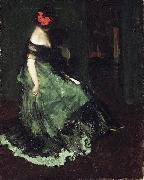 |
Charles Webster Hawthorne
|
|
(January 8, 1872 - November 29, 1930) was an American portrait and genre painter and a noted teacher who founded the Cape Cod School of Art in 1899.
He was born in Lodi, Illinois and his parents returned to Maine, raising him in the state where Charles' father was born. |
 |
Charles Napier Hemy
|
|
English Painter, 1841-1917, British painter, He was born at Newcastle-on-Tyne, of a musical family. He was trained in the Government School if Design, Newcastle, in the Antwerp academy and in the studio of Baron Leys. He returned to London in the 1870s. In 1881, he moved to Falmouth, Cornwall. He produced some figure subjects and landscapes, but is best known by his marine paintings. He was elected an Associate of the Royal Academy in 1898 and an Academician in 1910, Associate of the Royal Society of Painters in Water Colours in 1890 and member in 1897. Two of his paintings, "Pilchards" (1897) and "London River" (1904), are in the Tate collections. He had two brothers who were also artists, Thomas Hemy and Bernard Hemy. He died in Falmouth on September 30, 1917. |
 |
Charles Howard Hodges
|
|
(1764, Portsmouth - July 24, Amsterdam), was a British painter active in the Netherlands during the French occupation of 18th and early 19th century.
Charles Howard Hodges had visited Amsterdam in 1788; after a two-year stay in Dublin, he moved with his family to The Hague in 1792. In Amsterdam, he worked as an artist, specialized in the mezzotint technique and pastel. In 1797, he and his family moved to Amsterdam, where he lived with his teacher Johann Friedrich August Tischbein at the Prinsengracht Ne 205. There, he became a famous painter of portraits; he painted over 700 portraits of the rich and famous of that time. He was also an engraver, printer, art dealer and a member of the Amsterdam art club Felix Meritis.
He is well-known for the fact that he painted all the leaders of the Netherlands during the Napoleonic Period, -a turbulent period in Dutch history, since the Netherlands went through 5 different political systems: stadtholder Willem V of the Republic of the United Netherlands, Grand Pensionary Rutger Jan Schimmelpenninck of the Batavian Republic, King Louis Bonaparte (King of Holland), Emperor Napoleon Bonaparte and king William I of the Netherlands. The only known portrait of Sebald Justinus Brugmans was made by him. A design for the honorary cross of the Order of the Union was rejected by Louis Bonaparte.
Hodges advised the Dutch government in 1815 with the return of thousands of works of art, which were confiscated by the French in 1795 from several collections, including the Gallery of Prince William V (the first museum open to the public in the Netherlands), and the several collections of the previous stadtholders. Not all the stolen art was returned from Paris, and it is said that several pieces are still held in the Louvre up to this day.
Most of the over 700 portraits by Hodges are made in the early 19th century, the earlier works in pastel, and later work in oil paint. Several of these portraits can be found in the Rijksmuseum in Amsterdam, in museums and castles and in royal and private collections.
Charles Howard Hodges was father and teacher to James Newman Hodges, een lesser painter who worked in the Rijksmuseum when it was still located in the Trippenhuis in Amsterdam.
|
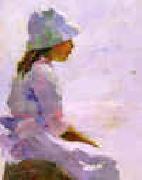 |
Charles Hawthorne
|
|
1872-1930
Charles Webster Hawthorne (January 8, 1872 ?C November 29, 1930) was an American portrait and genre painter and a noted teacher who founded the Cape Cod School of Art in 1899.
He was born in Maine, started as an office-boy in a stained-glass factory in New York, studied at night school and with Henry Siddons Mowbray and William Merritt Chase, and abroad in both Holland and Italy.
When he was eighteen, Hawthorne went to New York and studied painting at the National Academy of Design and the Art Students League. Among his teachers were Frank Vincent DuMond and George de Forest Brush. But Hawthorne declared that the most dominant influence in his career was William Merritt Chase, with whom he worked as both a pupil and assistant. Both men were naturally talented teachers and figurative painters who were drawn to rich color and the lusciousness of oil paint as a medium. Chase passed on a Munich tradition of tone values and tone painting, and Hawthorne learned all he could.
While studying abroad in Holland as Chase's assistant, Hawthorne was influenced to start his own school of art.
His winters were spent in Paris and New York City, his summers at Provincetown, Massachusetts, the site of his school. While in Paris Hawthorne became a full member of the French Soci??t?? Nationale des Beaux-Arts in 1917. |
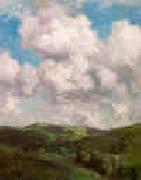 |
Charles Harold Davis
|
|
1856-1933
He was born at Amesbury, Massachusetts. A pupil of the schools of the Boston Museum of Fine Arts, he was sent to Paris in 1880. Having studied at the Acad??mie Julian under Jules Joseph Lefebvre and Gustave Boulanger, he went to Barbizon and painted much in the forest of Fontainebleau under the traditions of the men of thirty.
In 1890, Davis returned to the U.S., settling in Mystic, Connecticut. He shifted to Impressionism in his style, and took up the cloudscapes for which he became best-known. He eventually became a leading figure in the art colony that had developed in Mystic, and founded the Mystic Art Association in 1913.
He became a full member of the National Academy of Design in 1906, and received many awards, including a silver medal at the Paris Exhibition of 1889.
He is represented by important works in the Metropolitan Museum of Art, New York; the Corcoran Gallery of Art, Washington; the Pennsylvania Academy, Philadelphia, and the Boston Museum of Fine Arts. |
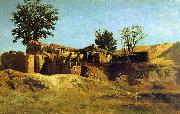 |
Carlos de Haes
|
|
Spanish
1826-1898
Carlos de Haes Galleries
Spanish painter of Belgian birth. In 1835 he moved with his parents to M?laga, where he studied under the court portrait painter and miniature painter Luis de la Cruz y R?os (1776-1853). In 1850 he returned to Belgium and studied with the landscape painter Joseph Quineaux (1822-95). During his studies there and on his travels in France, Germany and Holland, he became acquainted with contemporary Realist trends. He returned to Spain in 1855, becoming a naturalized Spaniard, and the following year he exhibited numerous landscapes at the Exposici?n Nacional, Madrid, to much acclaim. In 1857 he won the competition for the fourth chair of landscape painting at the Escuela de Bellas Artes in Madrid with View of the Royal Palace from the Casa de Campo (1857; Madrid, Real Acad. S Fernando), a work showing characteristics of the Barbizon and Fontainebleau landscape schools. In 1860 he was elected Acad?mico de m?rito at the Real Academia de S Fernando in Madrid. By 1861 he was officiating and drawing up the regulations for the landscape competitions for aspiring pensionnaires. Consequently plein-air works came to be required in place of the previous tradition of submitting historical landscapes executed in the studio, a practice that discouraged the study of nature. De Haes suggested that only final corrections should be made in the studio, an attitude that indicates his timid initiation and acceptance of Realist trends. |
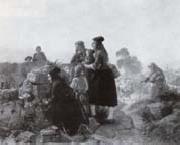 |
Carl Hubner
|
|
1814-1879, was a German genre painter. He was born at Konigsberg, and was a pupil of the Dusseldorf Academy. Hubner's works were especially popular in Holland and in North America, where he was received with enthusiasm in 1874. |
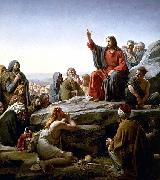 |
Carl Heinrich Bloch
|
|
(May 23, 1834 C February 22, 1890) was a Danish painter.
He was born in Copenhagen and studied with Wilhelm Marstrand at the Royal Danish Academy of Art (Det Kongelige Danske Kunstakademi) there.
His early work featured rural scenes from everyday life. From 1859 to 1866, Bloch lived in Italy, and this period was important for the development of his historical style.
His first great success was the exhibition of his "Prometheus Unbound" in Copenhagen in 1865. After the death of Marstrand, he finished the decoration of the ceremonial hall at the University of Copenhagen.
He was then commissioned to produce 23 paintings for the Chapel at Frederiksborg Palace. These were all scenes from the life of Christ which have become very popular as illustrations. The originals, painted between 1865 and 1879, are still at Frederiksborg Palace. |
 |
Carl Haag
|
|
1820 - 1915
German painter, active in Britain. After studying in Nuremberg, he painted miniature portraits in Munich and Brussels. In 1847 he went to London to study English techniques of watercolour painting and evolved a method that he claimed achieved the 'brilliancy of oil painting, combined with the tender-sweetness of water-colours' . From 1850 he exhibited at the Society of Painters in Water-Colours and was elected a full member in 1853. |
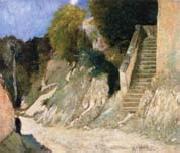 |
Carl Fredrik Hill
|
|
Swedish Painter, 1849-1911,Swedish painter and draughtsman. He grew up in the university city of Lund, where his father was a mathematics professor. Despite severe opposition from his father, he studied landscape painting at the Konstakademi in Stockholm (1871-2), under Johan Edvard Bergh and Per Daniel Holm (1835-1903). He also frequently copied Dutch Old Masters, particularly Jacob van Ruisdael. After seeing the work that Alfred Wahlberg had sent home from Paris, Hill began to abandon his initial approach to form and colour, and he left for Paris in November 1873. His most important experience there was his encounter with the painting of Jean-Baptiste-Camille Corot: 'Corot has discovered a new world, because he has discovered a new way of looking at the old', he wrote in a letter. Other contemporary French painters Hill admired were Alexandre-Gabriel Decamps, Charles-Fran?ois Daubigny, Jean-Franeois Millet and Theodore Rousseau. From Courbet he learnt how to use colour to suggest the surface texture of stone quarries and gravel hills. In Barbizon in 1874 and 1875 Hill met the Hungarian painters Laszlo Pael and Mihaly von Muncacsy. His paintings of this time, for example Autumn Landscape, Evening: Fontainebleau (1875; Malm?, Kstmus.), are characterized by their dark 'luminarism' and their debt to Corot's later works. |
|

